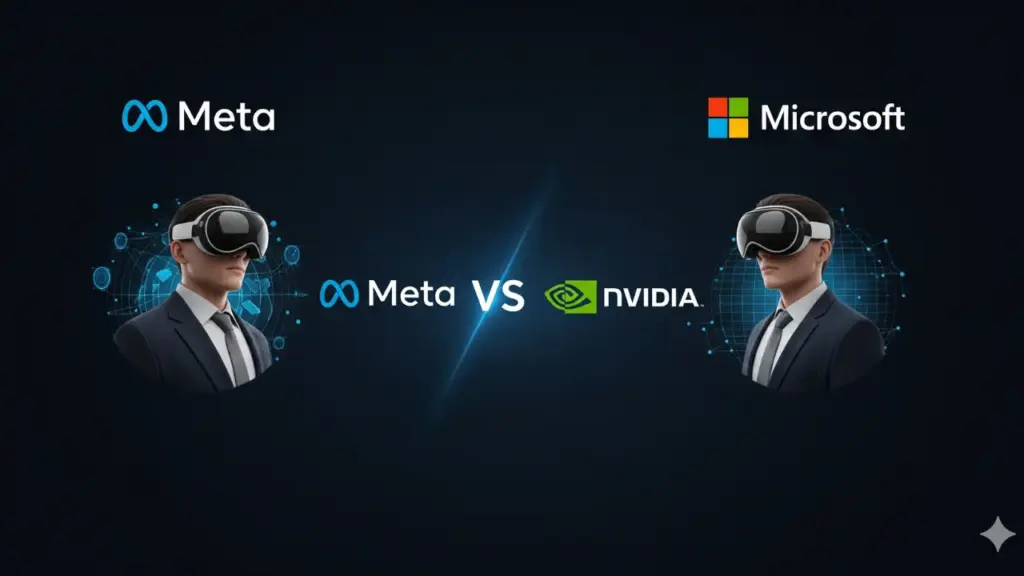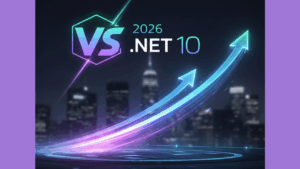Introduction: Why This Tech Shift Matters
Artificial intelligence and augmented reality are no longer futuristic buzzwords. They are real, fast-growing markets. Meta, NVIDIA, and Microsoft are at the center of this shift. Each company wants to dominate the next wave of technology. Meta is betting on smart glasses. NVIDIA fuels AI with its chips. Microsoft is trying to steer AI responsibly.
This blog explains what these moves mean for you. It shows how business leaders, entrepreneurs, and investors can stay ahead. It also shares why hiring a fractional CTO can give your startup an edge in this evolving landscape.
Meta’s Smart Glasses: The Apple Challenger
Meta’s new smart glasses are not just another gadget. They are a direct challenge to Apple’s Vision Pro and other AR devices. The glasses blend digital information with the physical world. They allow hands-free interaction, real-time translation, and instant photo capture. Meta has also improved design, battery life, and connectivity.
Apple’s Vision Pro is powerful but bulky and expensive. Meta aims to make AR more mainstream with lower prices and a lighter form factor. The goal is to repeat what Apple did with smartphones: make immersive computing normal. If Meta succeeds, it could own the next dominant hardware platform.
For startups and enterprises, AR is not just entertainment. It enables remote collaboration, immersive training, and new customer experiences. Companies exploring AR early can build loyalty and stand out. A fractional CTO with AR expertise can guide pilot projects, manage risk, and integrate AR into existing workflows without overloading internal teams.
Why Meta’s Hardware Bet Is Different
Meta has been investing billions in its Reality Labs division. Critics called it reckless spending. But the company sees AR as essential to its survival beyond social media ads. Smart glasses could tie users into Meta’s ecosystem for work, shopping, and play. They could also generate data for AI personalization.
Unlike Apple, Meta is willing to release products before the market is ready and iterate fast. This approach mirrors how software startups grow. Businesses can learn from this boldness. Testing emerging tech early creates first-mover advantages. Here, again, a fractional CTO can help evaluate prototypes, build minimum viable products, and secure technical partnerships.
NVIDIA’s Role: Fueling OpenAI and the AI Boom
While Meta fights Apple in hardware, NVIDIA powers the entire AI race. Its GPUs train and run the large language models behind ChatGPT, image generators, and autonomous systems. Without NVIDIA, OpenAI and similar companies would move much slower.
NVIDIA’s latest chips offer massive performance gains with lower energy use. This matters as AI workloads scale across industries. Financial services, healthcare, manufacturing, and logistics are adopting AI to cut costs and innovate.
For startups, relying on cloud providers with NVIDIA GPUs levels the playing field. You don’t need your own data center to build advanced AI. But you do need technical leadership to choose the right architecture, optimize costs, and ensure compliance. A fractional CTO can provide that leadership without the expense of a full-time hire.
How NVIDIA Shapes the AI Economy
NVIDIA is more than a chipmaker. It is building a full AI platform with software libraries, developer tools, and partnerships. This ecosystem makes it harder for competitors to catch up. It also creates opportunities for developers and small businesses to plug in and build new services.
Entrepreneurs should watch NVIDIA’s roadmap closely. New GPU releases can open or close entire market niches overnight. Working with a fractional CTO who tracks these changes can help you pivot quickly and avoid being locked into outdated tech.
Microsoft’s AI Concerns: Power and Responsibility
Microsoft invested billions in OpenAI and integrated its models into products like Copilot for Office, GitHub, and Azure. This gives it a powerful position in enterprise AI. But with power comes risk. Microsoft faces regulatory scrutiny, ethical debates, and competition from open-source AI.
The company has raised concerns about data privacy, misinformation, and AI bias. It wants clearer rules to ensure innovation without harm. For business leaders, this signals a shift. AI adoption will require not just speed but also governance.
Here, a fractional CTO can be critical. They can design AI workflows that respect privacy, meet compliance standards, and build user trust. This is no longer optional. Customers, regulators, and investors expect responsible AI.
What These Moves Mean for Business and Entrepreneurship
The combined actions of Meta, NVIDIA, and Microsoft show that the next decade of tech will blend hardware, software, and ethics. This creates both opportunity and complexity. Founders and executives must decide where to invest and how fast.
Augmented reality can transform marketing, customer support, and field operations. AI can automate analysis, content creation, and decision support. But choosing the wrong tools or scaling too quickly can waste money and damage reputation. An experienced fractional CTO brings strategic clarity. They translate hype into actionable roadmaps.
Investors should also pay attention. Meta’s smart glasses could trigger new AR startups. NVIDIA’s chips could spark specialized AI services. Microsoft’s policies could define the regulatory environment. Early insight lets you position your portfolio for growth.
Financial Implications of the AI Hardware War
Every major tech shift creates winners and losers. Hardware dominance affects software ecosystems, and vice versa. For example, if Meta’s glasses become mainstream, developers will rush to build AR apps. If NVIDIA’s GPUs remain the standard, cloud costs may rise but performance will soar. If Microsoft shapes AI governance, compliance-focused startups will thrive.
Business leaders must model these scenarios. What happens if your competitor adopts AR or AI before you? What if your vendor’s costs spike due to chip shortages? A fractional CTO can run these simulations, stress-test strategies, and help you budget for innovation without risking cash flow.

Staying Ahead in an Evolving Landscape
How can you stay ahead while Meta, NVIDIA, and Microsoft battle for dominance?
- Track trends, not headlines. Look beyond product launches to see long-term strategy.
- Experiment with small pilots. Use AR or AI in one department before scaling.
- Invest in flexible talent. A fractional CTO or specialized consultants can fill gaps quickly.
- Prioritize ethics and compliance. Build trust into your tech from day one.
This approach helps you learn fast, manage risk, and seize opportunity.
Conclusion: Your Edge in the AI-AR Revolution
Meta’s smart glasses could reshape how we interact with the digital world. NVIDIA’s chips will continue powering the AI boom. Microsoft’s stance on AI ethics may define the rules everyone must follow. Together, these shifts mark the start of a new era for business, technology, and investment.
For founders and executives, the lesson is clear: prepare now. Use experts, pilots, and flexible leadership to adapt quickly. A skilled fractional CTO can help you navigate the noise and focus on the real opportunities.
At StartupHakk, we believe staying informed and proactive is the best way to thrive in this fast-moving environment. By understanding the strategies of Meta, NVIDIA, and Microsoft, you can position your company to lead—not follow—in the AI and AR revolution.




